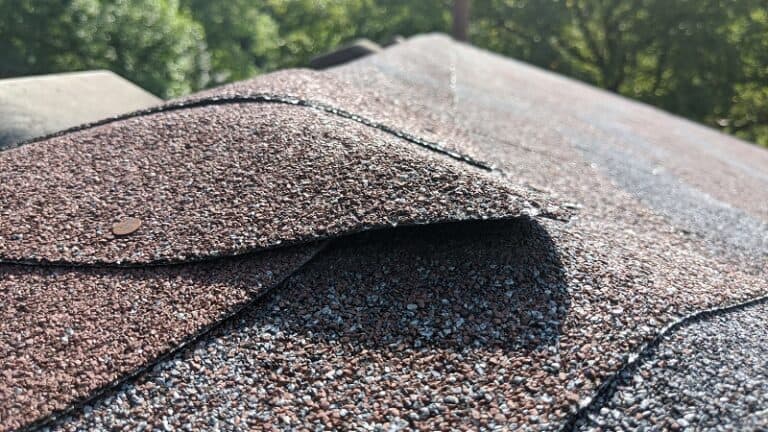Hail damage can be subtle or obvious, but spotting it early is essential to protect your home. Typically, hail damage appears as dents, bruises, or impact marks on shingles. One of the first signs is granule loss, which leaves bare or dark patches on the shingles. This weakens their protective coating and makes them more vulnerable to future weather damage.
Another common indicator is cracked or split shingles, which may show spiderweb cracks or clean breaks. You might also notice soft spots or bruising, which feel spongy when pressed. These indicate that hail has compromised the integrity of the shingle, even if the surface looks intact.
On metal roofing, hail usually leaves visible dents, while other materials like wood or composite may display punctures or chipping. Flashing, gutters, and vents may also show signs of impact damage.
Identifying hail damage quickly is crucial. Left unchecked, it can lead to leaks, water damage, and mold growth inside your home. Additionally, insurance companies often have strict deadlines for filing claims. Getting a professional inspection immediately after a storm ensures you don’t miss your window.
At Sellers Roofing Company, we offer free, no-obligation hail damage inspections. Our team will thoroughly assess your roof, document any damage, and help guide you through the insurance claim process if needed.
Call us today at (651) 703-2336 or schedule online for your FREE inspection.
What is Hail Damage?
First, let’s define what hail damage is. It occurs when constant downpours of rock-like substances ‘ping’ off your roof, roofing components (vents for example) and gutters. As many materials used, on roofing applications have the power to split off, into small or large chunks, there are many areas where you’d overlook cracking, denting even slight imperfections in gutter downspouts. Moreover, some homeowners don’t inspect their roofs after such storms on the assumption that only hurricanes can cause significant damage which is in fact is a very poor judgement to make that in the end could end up costing you thousands of dollars in repairs.

Common Signs of Hail Damage (Visual Cues)
Granule loss
Granules are the sandpaper-like part of the shingle. When a roof begins to, loose granules, the coating that comprises the asphalt starts to become exposed to the elements and as a result this leads to accelerated deterioration. Take a look in your gutters and downspouts after a hailstorm to see if any granules have come off your shingles.

Cracks in the shingles
During heavy hailstorms, big hail or high winds can grip the shingles and cause cracks. This can cause exposure and tears, leaving your roof with bare spots. When shingled are compromised in this manner, roof leaks are a common result.
Exposed roofing
Hail impact on a roof can shatter the shingles’ surfacing, causing it to interrupt far away from the fiberglass mat underneath. Additionally, there are cases where the damage isn’t obvious and the fiberglass is only, fractured.
In this case, it becomes slightly harder to detect and usually requires a trained eye. Fractured fiberglass mats may result in tears and cracks from some extent of hail impact.

Weakened self-seal strip
Heavy winds and hail can weaken the seal strength of your shingles. A weakened seal is what causes a shingle to detach and may leave your roof exposed to the weather.
Once a shingle is damaged, its integrity has been permanently compromised. This can lead to leaks, and it can cause other shingles around it to tear.

What does Hail Damage on Different Roofing Materials Look Like?
Asphalt and Composition Shingles Hail Damage
- Random damage with no discernable pattern.
- Hail hits that are black in color.
- Loss of granules, which can expose the roof felt.
- Asphalt and/or mat that appears shiny.
- Hail hits that are soft to the touch, just like the bruise on an apple.
Wood Shingles Hail Damage
- Random damage with no discernable pattern.
- A split in the shingle that is brown/orange in color.
- A split in the shingle that has sharp corners and edges.
- A split in the shingle that has little to no deterioration at the edges.
- Impact marks or dents along the splits.
Types of Roof Damage That Can Be Mistaken For Hail Damage
Additionally, there are several other kinds of discernible roof damage that can be mistaken for hail damage. For example, exposure to inclement weather and sunlight makes shingles brittle and provides them an aged appearance.
This type of injury is normal wear and tear of shingles, which is usually, misidentified as hail damage. Other sorts of normal wear and tear may include blistering, cracking, granule loss, flaking and algae.
Manufacturing defects and mechanical imperfections in shingles also can be mistaken for hail damage. Learning how to identify hail damage on a roof, even before the hail plagues your town, could help prevent roof fixing costs that could have been otherwise been avoided in advance.






